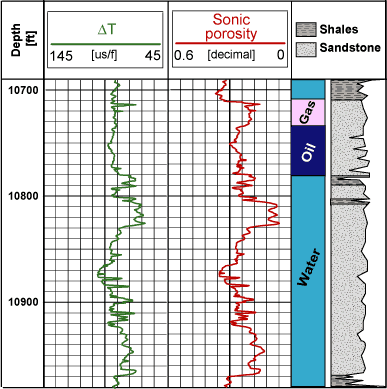The depth of investigation of sonic is not very high,
it is a tool which measures in the flushed zone. To obtain a measurement
of ![]() T in the
fresh zone, it is necessary to apply a correction. This correction is
carried out by adjusting the sonic log time-depth on a calibration point
provided by measurement on core sample of VSP.
T in the
fresh zone, it is necessary to apply a correction. This correction is
carried out by adjusting the sonic log time-depth on a calibration point
provided by measurement on core sample of VSP.
The ![]() T
is regarded as the weighted average of
T
is regarded as the weighted average of ![]() T
in the matrix
T
in the matrix ![]() Tma
and
Tma
and ![]() T in the
fluid
T in the
fluid ![]() Tfluid.
The simplest relation is given by the Wyllie's formula.
Tfluid.
The simplest relation is given by the Wyllie's formula.
Wyllie's formula
|
|
|
This formula which makes it possible to obtain porosity, is experimental and approximate. It is valid only for fresh and consolidated formations.

![]() Acoustic logging at Halle Fosse 2
Acoustic logging at Halle Fosse 2
In the uncemented formations or not compacted sands, the Wyllie's formula gives too high porosity.
In the presence of beds of clay interbedded among
sands, the values of porosity read by the sonic will be too high, ![]() T
clay >
T
clay > ![]() T sands.
T sands.
In the presence of secondary porosity (vacuolar porosity and porosity of fracture) the velocity of sound depending mainly on primary porosity, the porosity obtained by the sonic will be too low.
In this case the use of the neutron or density log will give us an order of magnitude of total porosity, and by substraction with sonic porosity there will be an idea of secondary porosity.
